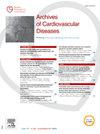Assessment of non-inferiority of a hospital-at-home care pathway for patients with acute heart failure: FIL-EAS-ic
IF 2.3
3区 医学
Q2 CARDIAC & CARDIOVASCULAR SYSTEMS
引用次数: 0
Abstract
Introduction
Acute heart failure (AHF) is a common cause of hospitalization and is associated with high mortality rates, long hospital stays and high economic costs worldwide. Novel care pathways are increasingly being considered to address these burdens. FIL-EAS-ic a mixed French conventional hospitalization and hospital-at-home (HaH) care pathway, under the responsibility of a multidisciplinary HF hospital team managing the city-hospital transition has been designed to reduce the length of hospital stay without compromising HF outcomes for patients.
Objective
The primary objective of the study described in this protocol will be to evaluate the non-inferiority of the FIL-EAS-ic pathway compared to conventional hospitalization, in terms of all-cause death and unscheduled HF hospitalization at 6 months.
Method
A randomized, prospective, (NCT04878263) was conducted from June 2021 to June 2023, involving two groups of patients in a 1:2 ratio: (A) a control group following the conventional hospitalization pathway, and (B) the experimental group following the FIL-EAS-ic pathway and including HaH when possible.
Results
361 patients were included (454 planned) and intention-to-treat analysis was carried out on 349 patients. The population had the following well balanced characteristics: 78.9 ± 11.7 years, female 43%, LVEF > 0.40 48%, with main reason for AHF hospitalization: congestive heart failure 57%, pulmonary edema 38%, right heart failure 3%, cardiogenic shock 5%. Analysis of the primary objective showed statistical non-inferiority (A) 33% vs. 25% (B), P < 0.001, without being able to demonstrate superiority (P Log-rank = 0.151, HR 0.74 [0.49,1.12]) (Fig. 1). In group B, 67% were admitted to HaH, resulting in a lower in hospital length of stay of 8.9 ± 5.5 days (A) vs 5.8 ± 5.2 days (B), P < 0.001. Moreover, access to HF education was higher (39% vs 7%, P < 0.001), as was the rate of vaccination against pneumococcus (53% vs 20%, P < 0.001) and COVID (91% vs 83%, P = 0.033), and the prescription of sacubitril-valsartan in HFREF (55% vs 23%, P < 0.001).
Conclusion
FIL-EAS-ic shows, in a very elderly population, that an HF team management of patients hospitalized for AHF, including early HaH hospitalization, is similar to conventional care, with a much shorter length of stay, and a higher quality in terms of access to education, vaccines and treatment.
急性心力衰竭患者医院-家庭护理途径的非劣效性评估:fil - easic
急性心力衰竭(AHF)是一种常见的住院原因,在世界范围内与高死亡率、长住院时间和高经济成本相关。人们越来越多地考虑采用新的护理途径来解决这些负担。fili - eas -ic是法国传统住院和住院日(HaH)混合护理途径,由多学科心衰医院团队负责管理城市-医院过渡,旨在减少住院时间,同时不影响心衰患者的预后。本研究方案中描述的主要目的是在6个月时全因死亡和计划外HF住院方面,与传统住院相比,评估fili - eas -ic途径的非劣效性。方法于2021年6月至2023年6月进行一项随机、前瞻性研究(NCT04878263),纳入两组患者,比例为1:2:(a)遵循常规住院途径的对照组,(B)遵循fili - eas -ic途径的实验组,并在可能的情况下包括HaH。结果纳入361例患者(计划纳入454例),对349例患者进行意向治疗分析。人群具有以下均衡特征:78.9±11.7岁,女性43%,LVEF >;0.40 48%, AHF住院主要原因:充血性心力衰竭57%,肺水肿38%,右心衰3%,心源性休克5%。主要目标分析显示统计学上的非劣效性(A) 33% vs. 25% (B), P <;0.001,但无法证明其优越性(P Log-rank = 0.151, HR 0.74[0.49,1.12])(图1)。在B组中,67%的患者住院时间缩短,分别为8.9±5.5天(a)和5.8±5.2天(B), P <;0.001. 此外,接受HF教育的比例更高(39% vs 7%, P <;0.001),肺炎球菌疫苗接种率也是如此(53% vs 20%, P <;0.001)和COVID(91%对83%,P = 0.033),以及在HFREF中使用苏比替-缬沙坦(55%对23%,P <;0.001)。结论:fil - easi -ic显示,在高龄人群中,心衰团队对AHF住院患者的管理,包括早期ha住院,与传统护理相似,住院时间短得多,在获得教育、疫苗和治疗方面质量更高。
本文章由计算机程序翻译,如有差异,请以英文原文为准。
求助全文
约1分钟内获得全文
求助全文
来源期刊

Archives of Cardiovascular Diseases
医学-心血管系统
CiteScore
4.40
自引率
6.70%
发文量
87
审稿时长
34 days
期刊介绍:
The Journal publishes original peer-reviewed clinical and research articles, epidemiological studies, new methodological clinical approaches, review articles and editorials. Topics covered include coronary artery and valve diseases, interventional and pediatric cardiology, cardiovascular surgery, cardiomyopathy and heart failure, arrhythmias and stimulation, cardiovascular imaging, vascular medicine and hypertension, epidemiology and risk factors, and large multicenter studies. Archives of Cardiovascular Diseases also publishes abstracts of papers presented at the annual sessions of the Journées Européennes de la Société Française de Cardiologie and the guidelines edited by the French Society of Cardiology.
 求助内容:
求助内容: 应助结果提醒方式:
应助结果提醒方式:


